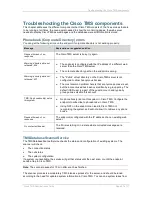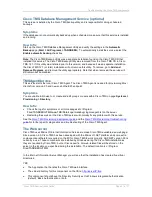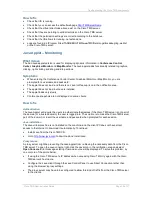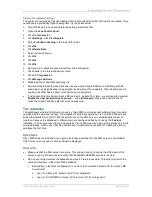
Phone Books
Cisco TMS Administration Guide
Page 23 of 37
Phone Books
There are three types of phone books available on Cisco endpoints:
Local Directory
The Local Directory is a file stored on the endpoint made by entries inserted through the remote
control on the endpoint. It is not touched by TMS, but can be imported into the Cisco TMS phone
books as an external source.
Global Directory
The Global Directory is a file stored on the codec where the entries cannot be changed via the remote
control. The file is transmitted by HTTP to all endpoints that are subscribing to one or more phone
books in Cisco TMS. Multiple phone books will be merged into one phone book. If containing more
than 400 entries, only the first 400 will be shown on the endpoint. The file will be transmitted to the
endpoint on the intervals set in the Administrative Tools > Configuration > General Settings >
Phone Books Update Frequency field.
Note: This only works on endpoints that support the globdir.prm file.
Corporate Directory
The Corporate Directory is an XML service on the Cisco TMS server that allows the endpoint to
retrieve the phone books directly from the server every time the phone book button on the endpoint is
pressed. It allows for a hierarchy of phonebooks and multiple phone numbers on every entry. The
Corporate Directory is also searchable.
Setting phone books on systems
There is a global setting in Cisco TMS (Administrative Tools > Configuration > General Settings >
General Settings pane > TANDBERG System Phone Books) that allows administrators to select
whether Corporate Directory, Global Directory, or both should be used in their network. Using both is
recommended since this will give the endpoints a failover option. If Cisco TMS is not reachable and
the Corporate Directory cannot be displayed, the Global Directory will show the 400 first entries in a
flat list.
To select which systems should get the different phone books, go to Phone Books in Cisco TMS,
click Set on Systems for a phone book, and select which endpoints should get this phone book.
Endpoints supporting both the Corporate Directory and the Global Directory will have their
Corporate Directory settings adjusted to point to the Cisco TMS server, and have the Global
Directory (the globdir.prm) file transmitted to the endpoint over HTTP at three different events:
•
every time adjustments to the Set on system list is made
•
at the intervals specified in the Update Frequency dropdown menu
•
by a background service that by default will run every four hours if Enforce Management
Settings on Systems is turned on (Administrative Tools > Configuration > Network
Settings > TMS Services pane > Enforce Management Settings on Systems field).
This globdir.prm file will then be available if the Cisco TMS server is offline. The entries will be
showed together with the local entries on the endpoint.
Endpoints such as Cisco TelePresence System MXP and Cisco Classic (E4/B9 or newer). The
Cisco Telepresence System Integrator C Series and Cisco IP Video Phone E20 do not support
the Global Directory.
Endpoints only supporting the Corporate Directory will only have the Corporate Directory settings
set on the system. This will happen every time a change is done to the Set on system list, and at
the intervals specified in the Update Frequency dropdown menu.





























